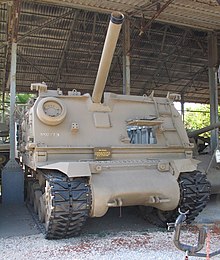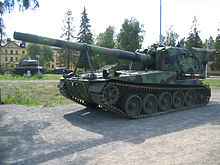Self-propelled artillery


Self-propelled artillery (also called mobile artillery or locomotive artillery) vehicles are a way of giving mobility to artillery. Within the term are covered Self-propelled guns (or howitzers) and rocket artillery. They are high mobility vehicles, usually based on caterpillar track carrying either a large howitzer or other field gun or alternatively a mortar or some form of rocket or missile launcher. They are usually used for long-range indirect bombardment support on the battlefield.
In the past, self-propelled artillery has included direct fire vehicles such as assault guns and tank destroyers. These have been heavily armoured vehicles, the former providing close fire-support for infantry and the latter acting as specialized anti-tank vehicles.
Modern self-propelled artillery vehicles may superficially resemble tanks, but they are generally lightly armoured, too lightly to survive in direct-fire combat. However, they protect their crews against shrapnel and small arms and are therefore usually included as armoured fighting vehicles. Many are equipped with machine guns for defense against enemy infantry.
The key advantage of self-propelled over towed artillery is that it can be brought into action much faster. Before the towed artillery can be used, it has to stop, unlimber and setup the guns. To move position, the guns must be limbered up again and brought - usually towed - to the new location. By comparison self-propelled artillery can stop at a chosen location and begin firing almost immediately, then quickly move on to a new position. This ability is very useful in a mobile conflict and particularly on the advance.
Conversely, towed artillery was and remains cheaper to build and maintain. It is also lighter and can be taken to places that self-propelled guns cannot reach, so despite the advantages of the self-propelled artillery, towed guns remain in the arsenals of modern armies.
History
Precursors

During the Thirty Year's War, early 17th century experiments were made with early types of horse artillery, batteries towed light field guns where most or all of the crew rode horses into battle. The gunners were trained to quickly dismount, deploy the guns and provide instant fire support to cavalry and act as a flexible reserve. The Russian army organized small units of horse artillery that were distributed among their cavalry formations in the early 18th century. While not forming large batteries and employing only lighter 3- and 2-pound guns, they were still effective and inflicted serious losses to Prussian units in the Seven Years' War. This inspired Frederick the Great to organize the first regular horse artillery unit in 1759. Other nations quickly realized the capability of the new arm and by the start of French Revolutionary Wars in 1790s Austria, Hannover, Russia, France, England and Sweden had all formed regular units of horse artillery. The arm was employed throughout the Napoleonic Wars and remained in use throughout the entire 19th century and into the first half of the 20th century, when advances in weapons technology finally made it obsolete.[1]
First World War

The first example of a self propelled gun was the First World War Gun Carrier Mark I of 1917. It was based on the first tank, the British Mark I which carried a heavy field gun. The gun could either be fired from the vehicle, or removed from it and set up as normal. In effect the carrier replaced the use of a separate horse team or internal combustion engine powered artillery tractor and allowed a new way for the gun to be used.
Between the wars
The next major advance can be seen in the Birch gun developed by the British for their motorised warfare experimental brigade after the end of the War. This mounted a field gun, capable of both the usual artillery trajectories and high angle anti-aircraft fire, on a tank style chassis. It was designed and built as part of a general approach to warfare where all arms, infantry and artillery included, would be able to operate alongside over the same terrains as the tanks.
Second World War


At the outbreak of World War II virtually all artillery was still being moved around by artillery tractors or horses. While the German Blitzkrieg doctrine called for rapid support of armoured units, during the invasion of Poland and France this was provided by the Luftwaffe using Stuka dive-bombers effectively acting as artillery and conventional towed howitzers.
As the War progressed, all nations developed self-propelled artillery. Some early attempts were often no more than a field gun or anti-tank gun mounted on a truck - a technique known as carrying portee. These were mobile but lacked protection for the crew. The next step was to mount the guns on a tracked chassis and provide an armoured superstructure to protect the gun and its crew. A lot of the initial designs were improvised and the lessons learned led to better designs later in the war. As an example the first British design "Bishop" carried the very effective 25 pdr gun-howitzer but in a mounting that severely limited the guns performance and it was replaced the following year by a design that lasted until the end of the war.
The Germans were particularly prolific with designs. They created many examples of lightly armored self-propelled anti-tank guns using captured French equipment (example Marder I) and light tank chassis (Marder II, Marder III). These led to better protected tank destroyers, built on medium or heavy tank chassis such as the German Jagdpanzer IV, Jagdpanther, Soviet SU-85, and SU-100, which were effectively turretless tanks. These had the advantage of being relatively cheap to build compared to proper tanks but at the expense of flexibility.
Heavily armoured assault guns, were designed to provide direct-fire support to infantry in the face of enemy defenses. Although often similar to tank destroyers, they carried larger caliber guns with weaker anti-armor performance but capable of firing powerful HE projectiles. The German StuH 42 and the Soviet SU-122 are good examples of this type of self-propelled artillery.
All major nations developed self-propelled artillery which would be able to provide indirect support while keeping pace with advancing armoured formations. These were usually lightly armoured vehicles with open-topped hull, US M7 Priest, British Sexton (25 pdr) and German Wespe being typical examples. A different route was chosen by the Soviets, which didn't develop a specialized indirect fire vehicle, but following a tradition of dual-purpose towed artillery built a series of versatile assault guns with indirect fire capabilities (example ISU-152). But probably the most important breakthrough was the development of the famous Soviet Katyusha self-propelled multiple rocket launchers which were unarmored trucks with a simple rocket rack on the back, a cheap and crushingly effective weapon.
After the end of the Second World War, the assault gun fell from use with a general trend towards a single heavy gun equipped vehicle, the main battle tank. Self-propelled artillery remained important and continued to develop alongside the general purpose field gun.
Modern self-propelled artillery


Mortars
Many vehicles have used ancillary smoke mortars for local defense. Considering vehicles with a mortar as a primary weapon, some vehicles are mortar "carriers" (transporters) and the mortar cannot be fired within the vehicle. Vehicles with a mortar as a primary weapon that is mounted to be fired within the vehicle include the US M21 half-track. Tanks such as the Israeli Makmat on the M4 Sherman tank chassis have also mounted mortars.
The Russian army uses a 2S4 Tyulpan (Tulipin) self-propelled 240 mm heavy mortar. Patria Hägglunds, a joint venture between Finnish Patria and Swedish BAE Systems Hägglunds manufactures AMOS (Advanced Mortar System) which is a 120 mm automatic twin barrelled, breech loaded mortar turret.
Howitzers and guns
Self-propelled artillery remains important in the equipment of many modern armies. It saw a significant role throughout the Cold War era conflicts and in the recent Gulf Wars.
Modern SP artillery is highly digitized with the ability to self survey firing positions using systems such as GPS and inertial navigation systems. This, in conjunction with digital fire control/ballistic computers and digital communications, allows individual guns to disperse over a wide area and still deliver rounds on target at the same time and same target as other guns in their battery.
These capabilities also increase survivability manyfold as modern SP artillery can displace and avoid counterbattery fire much more quickly and effectively and if desired more frequently than previously possible. In conjunction with modern logistic systems (where the SP gun's systems can track and report on ammunition consumption and levels) with similar navigation systems and palletised load dropping/lifting capabilities mean that the rapid displacement can occur without significant disruption to actually firing missions as it is possible for the ammunition to keep up with the guns.
A modern battery of six guns, each firing 43 kg projectiles with a burst firing speed of four rounds per minute, can deliver over a metric tonne of ordnance per minute for up to four minutes. This is an immense weight of fire which can be delivered with very high accuracy.
One example of the increased firepower provided by modern mobile howitzers is the latest version, the G6-52, of the 155 mm G6 howitzer. It can fire up to 6 rounds in quick succession which will land near simultaneously. This is achieved by firing the shells at different trajectories so that the first round has the longest flight time and the last round the shortest; made possible by an automated ammunition feed system. [1]
Rockets and missiles
Rockets have greater ranges and carry much more complex "shells" than guns since there is less of a restriction on size (calibre). The MLRS can be used to saturate a large area with sub-munitions.
Notes
- ^ Hedberg pp. 11-13
Sources
- Kungliga artilleriet: Det ridande artilleriet (1987) editor: Jonas Hedberg (summary in English) ISBN 91-85266-39-6
